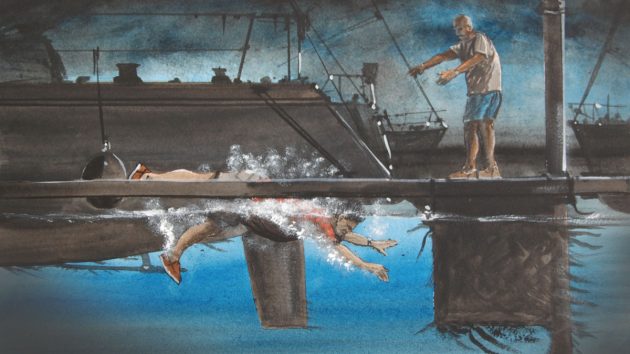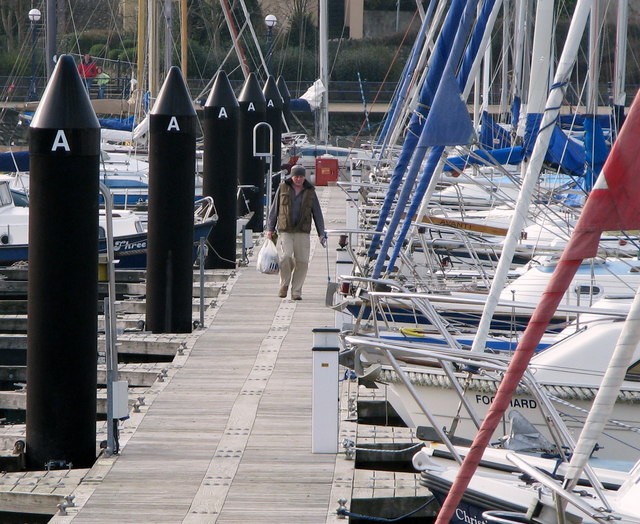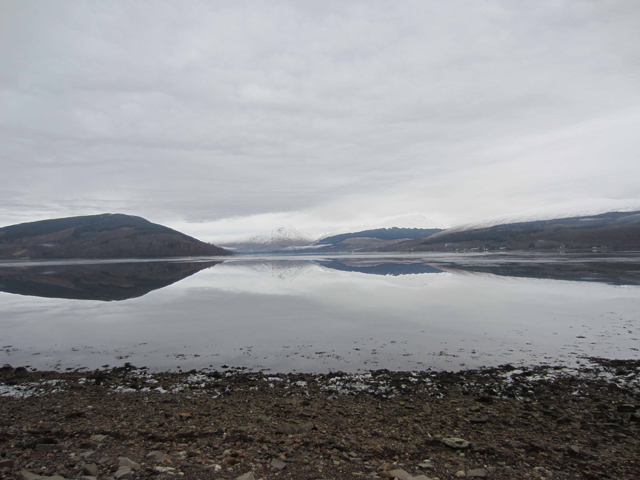Everyone thinks about man overboard (MOB), but what do you do when you have a MIM, man in marina? Mark Prior found out the hard way...
Two of the most dangerous things you will do on a boat? Get on it. And get off it. You are at your least aware and most distracted. There is much to trip over and fall foul of. Even more risk than of a badly placed preposition.
Bad enough should you slip into that dreaded no-person’s-land twixt pontoon and boat in full daylight, warm water, and your nickname is The Thorpedo.
My experience is that it doesn’t work like that. The casualty, for casualty they are, usually takes the plunge into icy water, late at night, has been well fed and watered, has not recently seen the inside of a gym, and is eagerly awaiting their next pension payment.

Cleats, warps and whoops-adaisy. Photo credit: Mark Prior

This is where it can all go wrong. Credit: Mark Prior
In the two incidents I have been involved with, one person was tiddly, the other absolutely hammered.
In the latest, my friend – to protect the embarrassed we’ll call him Fally McFall Face – went into slow motion. He began peddling an invisible unicycle like the boy in ET, in the direction of the drink, wearing the face of a particularly bewildered Stargazer fish.
Lacking anything but air to step on, he plunged, every limb flailing, into the gap between pontoon and transom. On the way down he appeared to successfully headbutt every solid object. On reflection, I cannot help but smile at the vision.
At the time, though, the situation had instantly become a matter of life and death: He may not be conscious. He might not resurface. The hypothermia clock had started ticking quite fast.
Spoiler here. He suffered only a few scuffs, scrapes and bruises, combined with severely damaged dignity and a drowned phone.
However, we did not know that then. I swore loudly and expertly, while trying to think what to do.
Based on my one previous experience, the absolutely first thing to do is: HANG ONTO THEM FOR DEAR LIFE.
By anything you can grasp at first and then by a wrist. It is a long way from a pontoon to a barely floating person and a wrist works well.
Do not hold hands. They are too slippy.
A pal told me that all he could grab of a child who had fallen into a marina was her hair, much to the horror then subsequent relief of her parents.

Even with good design and planning it can be impossible to remove all obstacles and trip hazards in a marina environment. Photo credit: Mark Prior
Shout for help
The fallee is now shocked and disorientated, panicking and possibly supine, so grabbing the casualty is paramount.
Of course, like being the pointing person on a seagoing MOB, that renders you out of action to do anything else. Time is also passing.
Very soon the victim’s brain will be telling limbs to take the rest of the night off as cold water shock takes its toll.
If you are on your own, and like most of us are not built like an All Black prop, shout HELP. Very loudly and regularly, because you absolutely need at least two people to retrieve Yer Soggy Person of adult weight.
With one person either side of the casualty it is relatively easy to hoick them up sufficiently far to hook your other arm under theirs and pull them out.
If you are not alone, it should be possible to lift out with two but if one of you cannot manage the lift, get them to drop a life ring in for extra reassurance.
Also, if there is a swim ladder on the boat, drop it. The victim may be able to use it. Then send your oppo to find or phone for extra bodies to help.
I decided that faffing about, getting a warp around the casualty was more trouble than it was worth.
First aid
Once removed from danger, normal first aid treatment should be applied. There we are. We shouted for help, fortunately it came and we retrieved him. We settled him down, wrapped him up warmly, and when he had recovered his wits, he was put under a warm shower.
Then his wife patched up his blessedly slight injuries, while, instead of tea and sympathy, berated him furiously for being such a twit. As you do.
The lessons learned are that falling into a marina is quite as life-threatening as falling into an ocean. Only a performing seal can leap out onto a pontoon.

Boatfolk Marinas staff fine-tuning their safety training
Marina ladders are not reachable once someone has dunked themselves, unless you are supremely confident they can swim to one. Unlikely in most circumstances.
You could go all RYA and wear lifejackets on pontoons, leave all manner of loops of line around your boat. Turn teetotal. Good ideas but not realistic.
PS: You simply couldn’t make this up. Within a week of this episode a visitor to the same boat took the plunge in the exact same place. What led to their topple was a tipple. A pattern emerges…
Lessons learned
- OK, this is trite, but the best MIM (man in marina) procedure is not to go overboard in the first place. Be spectacularly careful when hopping on and off a boat and negotiating narrow, wobbly pontoon fingers.
- A ladder is a great help because it is relatively easy to get on board if you have a step under the water. If you have a swim ladder, leave it deployed in the marina. If your casualty is compos mentis you can assist them to it, if you are confident they are capable.
- To prevent the ladder becoming slimy I use a waister line so it hangs just over the water. A solo casualty has only to pull on it for it to fully drop down. Stay safe everyone!
Cautionary tales

Artist Dick Everitt, former PBO deputy editor, shares a similar cautionary tale:
“Mark Prior highlights a very important ‘lesson learned’ in this article. I’ve met two round-the-world sailors who’ve admitted to nearly drowning in a similar way and it was the ‘embarrassment’ of possibly dying like this that sobered them up very quickly.
“Both were alone at the time and found it extremely difficult to climb out unaided, with alcohol and cold water shock making it worse.
“One was in a very basic marina but the other was equipped with emergency pontoon ladders. However, both got out using mooring lines and sheer willpower.
“The guy in the fancy marina reckoned he wouldn’t have made it to a safety ladder as the water was so cold… he also admitted to cycling along the pontoon and skidding on ice!
“Take care: I’m sure we’ve all been guilty of letting our guard down after a successful voyage, and celebrating a little too much!”
Article continues below…
Family of drowned pensioner appeal for more pontoon ladders
Heart attack may have caused hm to fall into marina
Quick-thinking teenager saves ‘Man Overboard’ Grandfather
A 13-year-old boy has been praised for his 'courage and quick thinking' after he saved to his Grandfather who had…
Man overboard: recovering a casualty from a marina
Rupert Holmes shares top tips on how to avoid the dangers of falling in while in a marina and how…
What the marinas say

Pontoon safety at Premier Marinas Swanwick & Universal
Even experienced boaters can misplace their footing, and with cold water an ever-present feature of UK boating, everyone should take care.
Premier Marinas Graham Bristowe, Marina Manager of Swanwick & Universal, Premier Marinas, said: “Falls into water are high on our list of potential risks for customers and for our own team.
“As such we invest a significant amount of time and resource to provide equipment and training on how to deal with these situations.
“Prevention is always the best approach and we aim to design-out trip hazards across our marinas where possible. Our team and our berth holders themselves are able to report anything of concern, with photographs, via our Premier Marinas app. Those reports land directly with our marina management who will take appropriate action.
Graham Bristowe, Marina Manager of Swanwick & Universal, Premier Marinas
“We work with our customers to ensure pontoons are left as clear as possible – no overhanging anchors, dinghies or paddleboards, and particularly ensuring that ropes, water pipes and any cabling are appropriately managed. That said accidents do happen especially when climbing onto or off of vessels, and that’s why we insist our staff always wear correctly fitted lifejackets while on the marina pontoons and we actively encourage everyone else to do the same, especially in poor weather.
“One personal plea would also be to make sure lifejackets are serviced regularly – it could make all the difference when you need it.
“All our new customers are invited to join face to face inductions with our marina teams and that helps them understand the various safety kit and its positioning around the marina. Our pontoons have highly visible safety ladders and additional safety boxes with life rings and throw lines available.
New long reach and rescue pole at Premier’s Universal Marina
“We have recently installed long reach and rescue poles as an added feature at our Noss on Dart and Universal marinas and we aim to roll out further equipment to all our sites.
“Even experienced boaters can misplace their footing, and with cold water an ever-present feature of boating in the UK everyone should take care.
“Cold water shock is a real threat and the standard advice if you end up in the water unexpectedly is worth noting;
- Allow a minute for the initial effects of cold water shock to pass.
- Don’t try to swim straight away.
- Relax and float on your back to catch your breath.
- Try to get hold of something that will help you float.
- Keep calm then call for help or swim for safety if you’re able.
“While incidents are not that common they do happen. With some simple forethought the frequency can be reduced and the impacts lessened.”

Joe Walton, head of health, safety and environment at MDL Marinas
MDL Marinas Joe Walton, head of health, safety and environment at MDL Marinas, said: “We provide a Safety First Policy for our customers to highlight marina specific safety.
“This includes a section on pontoons, explaining that pontoons, although designed and fit for purpose, are subject to continual movement, can be unstable and may be slippery in wet or icy conditions and that extreme care should be taken at all times not to jump onto pontoons when coming alongside or disembarking a vessel.
“We also recommend that everyone should always consider wearing a lifejacket when on pontoons or on the water.”
He added: “It’s MDL policy that all staff must wear their lifejackets on the pontoons or on the water and basic training includes how to assist someone who has fallen into the water by using the various items of safety equipment located at each marina.
“On all our pontoons, there are life rings with throwlines, and reach and rescue safety equipment. Safety ladders are located around the marinas and although indicated by pontoon signage, MDL also advises customers to take a note of where the safety ladders are in case of an emergency situation and to remember that transom ladders on boats or other parts of vessels can be useful to aid extraction if someone falls into the water.”

Marina teams at MDL Marinas took part in bespoke RNLI water safety training sessions in May and June 2022
Boatfolk Marinas Simon Haigh, managing director of Boatfolk Marinas, said: “Falling into the water is not an uncommon occurrence, but luckily one that isn’t happening daily. Typically, for a medium sized marina it happens a handful of times each summer season and usually less than 10 times in a year.
“At all our marinas we have safety equipment to ensure that in the case of someone falling in they will be safely back on dry land in no time.
“This includes a Jacob’s Cradle, a portable lifting device that acts as an easily climbable net, or it can be deployed as a hammock to lift people out of the water who need more assistance. All around our marinas are clear safety instructions to help reduce the risk of falling in and to assist people out of the water.
“There are several industry regulations in terms of practices and equipment that all our marinas fully comply with. A primary safety requirement that helps mitigate the dangers associated with falling into a marina is the TYHA safety ladder requirements under the Marina Industry Code of Practice regulations. These safety ladders provide exit points from the water and are dotted around the marina.
“In the event of an accident, we have fully trained staff able to analyse the situation and quickly deploy the right equipment to aid in a recovery. All operating staff have been briefed on the marina’s specific risk assessment and operating procedures, so know exactly what to do when someone falls in.
“After a recovery has been completed and the individual is checked to see if they need any further help, all accidents are reported in our system and categorized by severity. We then assess what actions, if any, could be made to further reduce the risk of a repeat accident.
“To help reduce the risks of people falling in and to make sure they know what to do if they do, we run regular water safety sessions for all our customers. We want to make sure our marinas are as safe as possible so that people can enjoy being on and around the water as much as possible.
Simon Haigh, managing director of Boatfolk Marinas
“Our general advice is:
- Whenever you are moving about on your boat or around the marina to wear a lifejacket when close to the water.
- Ropes and other tripping hazards tend to be attached to the edge of pontoons and jetties, so stick to the centre of walkways but stay aware of any possible hazards.
- If you do fall in, stay calm and tread water while looking out for any approaching dangers before looking for an exit.
- Although it can be embarrassing, we always advise to call out and make others aware that you’re in the water, not only so that you can receive help, but also so that watercraft know to avoid you.
- Never swim between two moored boats as there is a risk they will move together.
- Look for the closest exit ladder which provides a much easier exit point than climbing directly up onto the jetty. Calmly swim over, get yourself out of the water and dry yourself off.
- If the water is at all cold, make sure you let someone know you fell in; even a short exposure can result in hypothermia.”
Why not subscribe today?
This feature appeared in the October 2022 edition of Practical Boat Owner. For more articles like this, including DIY, money-saving advice, great boat projects, expert tips and ways to improve your boat’s performance, take out a magazine subscription to Britain’s best-selling boating magazine.
Subscribe, or make a gift for someone else, and you’ll always save at least 30% compared to newsstand prices.
See the latest PBO subscription deals on magazinesdirect.com










